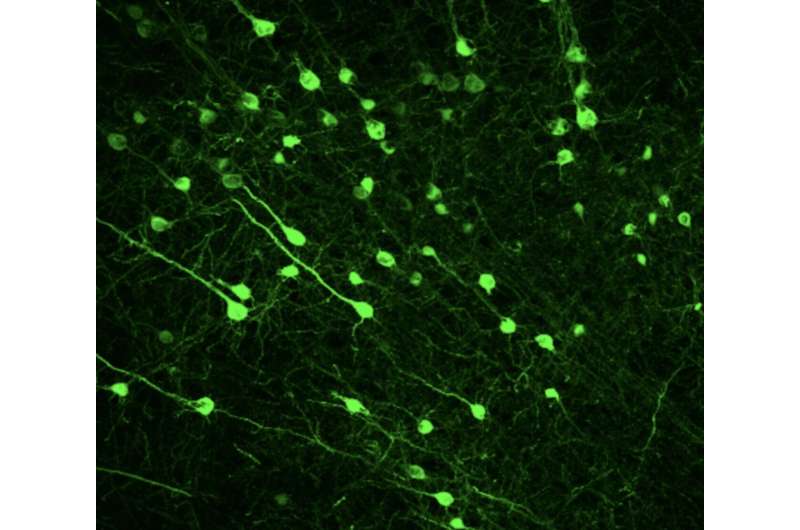February 6, 2023 feature
This article has been reviewed according to Science X's editorial process and policies. Editors have highlighted the following attributes while ensuring the content's credibility:
fact-checked
peer-reviewed publication
trusted source
proofread
A neural substrate that may modulate sex differences in motivation

Psychology research conducted over the past few years suggests that males and females can preferentially engage in different decision-making strategies. The precise neural underpinnings of these reported gender differences in decision-making, however, remain unclear.
Researchers at Princeton University have recently carried out a study aimed at better understanding what neural substrates may underlie observed sex differences in decision-making. Their paper, published in Nature Neuroscience, highlights differences in motivation to pursue rewards in male and female mice, which appeared to be modulated by the same neural substrate.
"Until recently, female subjects were largely excluded from neuroscience research, especially in research using animal models," Julia Mary Cox, one of the researchers who carried out the study, told Medical Xpress. "Studying sex differences in the brain is important, because many psychiatric diseases, including depression and schizophrenia, are marked by pronounced sex differences in prevalence, as well as by changes in decision-making and motivation."
Past studies suggest that male and female rats make decisions in different ways. For instance, when making choices that entail the expectation of certain outcomes (e.g., receiving a food reward or a small electric shock), females were found to be more sensitive to negative outcomes. Cox and her colleagues set out to explore the neural mechanisms that contribute to these sex differences.
"In this study, we identified sex differences in motivation to engage in a decision-making task and tried to determine whether there were differences in how the anterior cingulate cortex or AAC (a region of the brain important for decision making) regulates motivation in males and females," Cox explained.
To conduct their experiments, the researchers first trained a group of male and female mice to perform a simple decision-making task. In this task, the mice could choose to press one of two levers, in the hope that it would release a reward (i.e., sugar water).
The mice could also decide when to perform the task (i.e., when to press the levers), which reflected their motivation. During the task, choice and motivation were guided by the mice's recent choices and whether they resulted in a reward or not.
Interestingly, Cox and her colleagues found that when they did not receive a reward in previous trials, female mice waited a longer time before trying again (i.e., pressing the next lever). This is aligned with previous findings that suggest females are more sensitive to negative outcomes.
"Motivation in females was more sensitive to this experience, in that took longer for females to engage in the task when they didn't receive reward for their recent lever presses," Cox explained.
Cox and her colleagues subsequently used viruses to express a light-activated protein in neurons of the AAC that project onto the dorsomedial striatum (DMS), another brain region known to play a key role in decision-making. The selective expression of this protein decreased the activity of these AAC-DMS neurons whenever a light was applied to the brain of the mice.
In other words, the team was able to temporarily reduce the activity of AAC-DMS neurons involved in decision-making as the mice were making decisions. They then observed how the temporary blocking of these neurons affected their behavior.
"We also imaged the activity of these neurons while mice performed the decision-making task," Cox said. "We expressed a different protein in the ACC-DMS neurons that fluoresces when the neurons are active. We used a miniaturized microscope that the mice can wear on their heads while they performed the task and then looked at how activity in individual neurons changed based on different types of information (e.g., whether they received a reward or not) that regulates the motivation of the mice."
The researchers' experiments yielded very interesting results. As they had anticipated, they found that female mice were more sensitive to negative outcomes than males, yet they could also identify a neural circuit that contributes to this female-specific behavior.
"We also found sex differences in how reward information was represented in this circuit," Cox explained. "Specifically, more neurons in the female ACC were active during negative outcomes compared to males."
This recent work by Cox and her colleagues offers new and valuable insight about the neural substrates underlying previously documented sex differences in motivation and decision-making behaviors. In the future, this insight could contribute to the neuroscientific understanding of psychiatric disorders that are most prevalent in men or women and that are known to affect decision-making.
"In our next studies, we plan to explore what parts of the brain regulate motivation in the males and how stress (e.g., social isolation) affects motivation and the representation of reward in this part of the brain," Cox added.
More information: Julia Cox et al, A neural substrate of sex-dependent modulation of motivation, Nature Neuroscience (2023). DOI: 10.1038/s41593-022-01229-9
© 2023 Science X Network




















